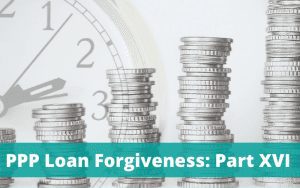What Is an RMD (Required Minimum Distributions) and What You Need to Know
As your accountants (and often financial advisors), we generally warn our clients against withdrawing from their retirement savings early. We feel having access to that cash in retirement or during a crisis could save people from borrowing money just when they’re trying to reduce or eliminate debt. And with the early-withdrawal penalties, the idea of using retirement money becomes even less attractive. We have slightly different views as the laws about withdrawals changed in March 2020 because of the coronavirus. Here’s an overview of RMDs (Required Minimum Distributions) under COVID-19 :
As it relates to retirement accounts, the U.S. Government:
- Passed the Coronavirus Aid, Relief, and Economic Security (CARES) Act in March of 2020 for which Section 2202
- Relaxes the rules around early withdrawals and rollover policies.
- Gives retirees, who are usually required to take money from their retirement accounts every year, a break: No required minimum distributions (RMDs) are necessary for 2020.
- Indicates that permissible loans from certain retirement plans have been expanded.
- Had passed the “Setting Every Community Up for Retirement Enhancement” (SECURE) Act in late 2019 that raised the age for RMDS applying to defined-contribution plans (like 401(k)s and traditional IRAs) from 70.5 to 72 years.
The RMD penalty waiver was part of the solution to help mitigate the economic impact on individuals, governments, and businesses. The RMD waiver affects other rollover rules. Knowing what the rules are and how they can affect you will let you avoid costly mistakes.
If you know what an RMD is, skip the next section, and look to the following segment for information about RMDs during COVID-19.
What is a Required Minimum Distribution
Click HERE for more details from the IRS, (like how to calculate it, and the beginning date) but here’s a starter.
“Your required minimum distribution is the minimum amount you must withdraw from your account each year.
- You can withdraw more than the minimum required amount.
- Your withdrawals will be included in your taxable income except for any part that was taxed before (your basis) or that can be received tax-free (such as qualified distributions from designated Roth accounts).”
The minimum distribution rules apply to:
|
|
|
|
|
|
|
|
IRS Rules for RMDs under COVID-19
IRS Coronavirus RMD Overview
“Qualified individuals affected by COVID-19 may be able to withdraw up to $100,000 from their eligible retirement plans, including IRAs, between January 1 and December 30, 2020.
“These coronavirus-related distributions aren’t subject to the 10% additional tax that generally applies to distributions made before reaching age 59 and a half (59-1/2), but they are still subject to regular tax. Taxpayers can include coronavirus-related distributions as income on tax returns over a three-year period. They must repay the distribution to a plan or IRA within three years.
“Some plans may have relaxed rules on plan loan amounts and repayment terms. The limit on loans made between March 27 and September 22, 2020, is raised to $100,000. Plans may suspend loan repayments due between March 27 and December 31, 2020.”
The IRS rules continue with these important details.
“Qualifications for Relief as the law defines a qualifying person as someone who:
- Has tested positive and been diagnosed with COVID-19
- Has a dependent or spouse who has tested positive and been diagnosed with COVID-19
- Experiences financial hardship due to them, their spouse, or a member of their household:
- Being quarantined, furloughed, or laid off or having reduced work hours
- Being unable to work due to lack of childcare
- Closing or reducing hours of a business that they own or operate
- Having pay or self-employment income reduced
- Having a job offer rescinded or start date for a job delayed
“Employers can choose whether to implement these coronavirus-related distribution and loan rules.
“Qualified individuals can claim the tax benefits of coronavirus-related distribution rules even if plan provisions aren’t changed. Administrators can rely on an individual’s certification that they’re a qualified person.”
IRS Frequently Asked Questions
There are fifteen questions and answers on this IRS Page that address coronavirus related distributions. They’re great questions, and we hope you check them out! The answers are all on this page.
Q1. What are the special rules for retirement plans and IRAs in section 2202 of the CARES Act?
Q2. Does the IRS intend to issue guidance on section 2202 of the CARES Act?
Q3. Am I a qualified individual for purposes of section 2202 of the CARES Act?
Q4. What is a coronavirus-related distribution?
Q5. Do I have to pay the 10% additional tax on a coronavirus-related distribution from my retirement plan or IRA?
Q6. When do I have to pay taxes on coronavirus-related distributions?
Q7. May I repay a coronavirus-related distribution?
Q8. What plan loan relief is provided under section 2202 of the CARES Act?
Q9. Is it optional for employers to adopt the distribution and loan rules of section 2202 of the CARES Act?
Q10. Does section 2202 of the CARES Act provide additional distribution rights to participants or otherwise change the rules applicable to plan distributions?
Q11. May an administrator rely on an individual’s certification that the individual is eligible to receive a coronavirus-related distribution?
Q12. Is an eligible retirement plan required to accept repayment of a participant’s coronavirus-related distribution?
Q13. How do qualified individuals report coronavirus-related distributions?
Q14. How do plans and IRAs report coronavirus-related distributions?
Q15. Are employees who participated in a business’s qualified retirement plan, then laid off because of COVID-19 and rehired by the end of 2020, treated as having an employer-initiated severance from employment for purposes of determining whether a partial termination of the plan occurred? (added July 30, 2020).
Remember, the answers are all on this page.
We hope you look at them and CALL US if you have trouble reading the fine print. (Actually, that’s what we LIKE to do!)
Other Things to Think About Before YOU CALL us
- How do you suspend scheduled RMDs? If you’re taking periodic distributions from your IRS, this is an incredibly important question. Why? Because only one of those distributions would be eligible to be rolled over to the same sort of IRA from which the distribution was made.
- Our understanding is that the RMD waiver does not preclude you from taking distributions:If you are relying on those distributions to cover living expenses, you can still take them. These are voluntary distributions, and the RMD rules don’t apply.
- Double check with us on this one. Ineligible rollovers could create excess contributions: A rollover that does not qualify for a waiver and misses the 60-day deadline and, or a rollover that breaks the one-per-year rollover rule would be an excess contribution in the account where the rollover is going. For an Individual Retirement Account (IRA), the excess contribution would result in the IRA looking at a 6% excise tax on the excess amount, specifically if the surplus contribution is not corrected by the account owner’s tax filing due date, plus extensions. This 6% excise tax would be applied for every year that the excess stays in the IRA.
- Ask us for help on how to rollover amounts that are not RMDs as a result of the waiver: These tricky rollovers need to adhere to statutory requirements and follow the trustee’s or financial institution’s operational requirements.
BOTTOM LINE: As you can see, there are many things to know about retirement accounts. If you are approaching retirement age, it is wise to remember that the rules are strict; and enforced. And they change (as in the case of COVID-19).
Even if you are not nearing retirement, your family members or your employees might be wondering what to do because it’s all pretty complicated. We have people on our team and resources through our financial and legal partners who help us with the heinously complicated cases.
Please, contact us if you have any questions.




